Start menu/taskbar can only be on bottom on W11? That's fucking shit.

 www.microsoft.com
www.microsoft.com
Windows 11 Specs and System Requirements | Microsoft Windows
Find an overview of Windows 11 specs and features from Microsoft. Learn about the device specifications, versions and languages available for Windows 11
Last edited:






